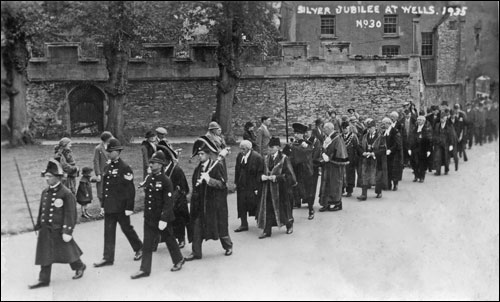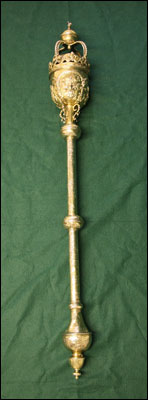How it all started
The great charter of Queen Elizabeth I in 1589 granted the borough the right to appoint two Serjeants-at-Mace (or Mace-Bearers). So we know that the custom of carrying maces as symbols of civic authority in Wells dates from then (although we have no evidence prior to this). The office of Serjeant-at-Mace continues to the present day.
 The 1589 charter stated that one of the Serjeants-at-Mace was to be chosen by the Mayor and the other by the common council. They had various roles, including “the lawful execution of processes, mandates and other businesses lawfully to be executed”. They had to assist as attorneys at the new court of record too, swearing all panels of inquiry, orders and warrants. The charter also granted a prison to the new Corporation and its warden was to be one of the Serjeants-at-Mace.
The 1589 charter stated that one of the Serjeants-at-Mace was to be chosen by the Mayor and the other by the common council. They had various roles, including “the lawful execution of processes, mandates and other businesses lawfully to be executed”. They had to assist as attorneys at the new court of record too, swearing all panels of inquiry, orders and warrants. The charter also granted a prison to the new Corporation and its warden was to be one of the Serjeants-at-Mace.
By 1835, the Mace-Bearers were acting as “peace officers” as well as attending the mayor and common council. They had a gown and hat for state occasions. After the Municipal Corporations Act of that year, they served as Day Police Constables as well as Serjeants-at-Mace.
This photograph to the left is copyright of the Wells & Mendip Museum.
Nowadays their role is largely ceremonial, being primarily to attend and accompany the council.They also assist the council in its civic functions which occur throughout the year and, most importantly, take personal responsibility for the safe-keeping of the council's maces at all such events. They lend gravitas to the varied functions that the Mayor and councillors attend, and ensure that the traditions associated with the mayoral role are maintained.
The Maces
 Queen Elizabeth I’s charter of 1589 ordered that the two Serjeants-at-Mace of Wells should carry “maces of gold or silver, engraven and wrought with the sign of the arms of our kingdom of England”.
Queen Elizabeth I’s charter of 1589 ordered that the two Serjeants-at-Mace of Wells should carry “maces of gold or silver, engraven and wrought with the sign of the arms of our kingdom of England”.
The original maces were employed until 1641, when they were sold in London for £3 1s 7d and replaced by new ones costing £25 5s. These appear to have continued in use throughout the Civil War and Common wealth periods.
The present elaborately ornamented, silver-gilt maces were acquired in 1660, shortly after the Restoration of Charles II that year. Their purchase for £38 10s (a figure equivalent to nearly £5000 today) from a Mr Gallington, probably in London, is recorded in the Corporation accounts for that year.
Maces were originally used as weapons. They were a type of club with a heavy head (sometimes spiked) at the end of a handle; a Mace-Bearer's job was to literally protect the council with their maces.
The ceremonial maces which are used nowadays in civic, parliamentary and academic ceremonies derived from these. They are ornamented staffs which represent the authority of a high official (such as the sovereign) or institution.
As for ceremonial maces, which symbolise the power or status of a Monarch, institution or high dignitary, the duty to carry them in procession or other formal occasions may either be occasional and vested in an office otherwise named, or give its name to the office.
The mace had another purpose and that was to identify the Mayor who, after all, was authorised by the King.
The mace is used at official ceremonies such as Mayor Making when a new Mayor takes office. It is also used at full Council meetings. The meeting is not properly constituted if the mace is not there and so no business can be undertaken. Similarly the Speaker can stop a meeting by asking that the mace is removed. The mace is used at Civic Services, Remembrance Sunday and Freedom of the Borough events. If the Queen is present, the mace is reversed, which signifies that the Mayor is surrendering the token of his power.
Civic History Council History History
Share